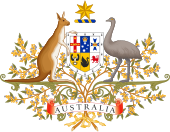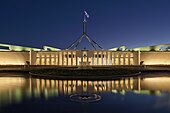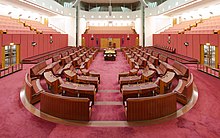
Back Witenagemōt of Australie ANG برلمان أستراليا Arabic Parllamentu d'Australia AST Парламент Аўстраліі Byelorussian Parlament de la Mancomunitat d'Austràlia Catalan پەرلەمانی ئوسترالیا CKB Australský parlament Czech Australiens parlament Danish Australisches Parlament German Parlamento de Aŭstralio Esperanto
Parliament of the Commonwealth | |
|---|---|
| 47th Parliament of Australia | |
 | |
 | |
| Type | |
| Type | |
| Houses | Senate House of Representatives |
| History | |
| Founded |
|
| Leadership | |
Charles III since 8 September 2022 | |
Sam Mostyn since 1 July 2024 | |
| Structure | |
| Seats | 227 (151 MPs, 76 Senators) |
 | |
House of Representatives political groups | Government (78)
|
 | |
Senate political groups | Government (25)
|
Length of term | House: 3 years (maximum) Senate: 6 years (fixed except under double dissolution) |
| Elections | |
| Preferential voting with full preferences[2] | |
| Single transferable vote (proportional representation)[2] | |
Last House of Representatives election | 21 May 2022 |
Last Senate election | 21 May 2022 (half) |
Next House of Representatives election | 2025 |
Next Senate election | 2025 (half) |
| Redistricting | Redistributions at least every seven years in each state and territory by the Redistribution Committee[3] |
| Meeting place | |
 | |
| House of Representatives Chamber | |
 | |
| Senate Chamber | |
| Website | |
| aph | |
| This article is part of a series on the |
| Politics of Australia |
|---|
 |
| Constitution |
|
|
The Parliament of Australia (officially the Parliament of the Commonwealth[4] and also known as the Federal Parliament) is the federal legislature of Australia. It consists of three elements: the monarch of Australia (represented by the governor-general), the Senate (the upper house), and the House of Representatives (the lower house).[4] It combines elements from the Westminster system, in which the party or coalition with a majority in the lower house is entitled to form a government, and the United States Congress, which affords equal representation to each of the states, and scrutinises legislation before it can be signed into law.[5]
The upper house, the Senate, consists of 76 members: twelve for each state, and two for each of the self-governing territories. Senators are elected using the proportional system and as a result, the chamber features a multitude of parties vying for power.[6] The governing party or coalition has not held a majority in the Senate since 1981 (except between 2005 and 2007) and usually needs to negotiate with other parties and independents to get legislation passed.[7]
The lower house, the House of Representatives, currently consists of 151 members, each elected using full preferential voting from single-member electorates (also known as electoral divisions or seats).[8][9] This tends to lead to the chamber being dominated by two major political groups, the centre‑right Coalition (consisting of the Liberal and National parties) and the centre‑left Labor Party. The government of the day must achieve the confidence of this House in order to gain and remain in power.
The House of Representatives has a maximum term of three years, although it can be dissolved early. The Senate has fixed terms, with half of the state senators' terms expiring every three years (the terms of the four territory senators are linked to House elections). As a result, House and Senate elections almost always coincide. A deadlock-breaking mechanism known as a double dissolution can be used to dissolve the full Senate as well as the House if the Senate refuses to pass a piece of legislation passed by the House.[10]
The two houses of Parliament meet in separate chambers of Parliament House (except in rare joint sittings) on Capital Hill in Canberra, Australian Capital Territory.
- ^ "The First Commonwealth Parliament 1901". Australian Electoral Commission. Archived from the original on 2 December 2023. Retrieved 28 November 2023.
- ^ a b "Federal elections". Parliamentary Education Office. 10 November 2023. Archived from the original on 17 December 2023. Retrieved 17 December 2023.
- ^ Muller, Damon (25 August 2022). "The process of federal redistributions: a quick guide". Parliament of Australia. Research Paper Series, 2022–23.
- ^ a b Australian Constitution s 1 – via Austlii.
- ^ Beck, Luke (2020). Australian Constitutional Law: Concepts and Cases. Cambridge University Press. pp. 16–25. ISBN 978-1-108-70103-7. OCLC 1086607149.
- ^ "Odgers' Australian Senate Practice Fourteenth Edition Chapter 4 – Elections for the Senate". Parliament of Australia. 2017. Archived from the original on 9 May 2019. Retrieved 25 March 2017.
- ^ Williams, George; Brennan, Sean; Lynch, Andrew (2014). Blackshield and Williams Australian constitutional law and theory : commentary and materials (6th ed.). Annandale, NSW: Federation Press. p. 415. ISBN 9781862879188.
- ^ "House of Representatives Practice, 6th Ed – Chapter 3 – Elections and the electoral system". Parliament of Australia. 2015. Archived from the original on 27 March 2022. Retrieved 25 March 2017.
- ^ "A Short History of Federal Election Reform in Australia". Australian Electoral Commission. 8 June 2007. Archived from the original on 4 March 2022. Retrieved 1 July 2007.
- ^ "Odgers' Australian Senate Practice Fourteenth Edition Chapter 21 – Relations with the House of Representatives". Parliament of Australia. 2017. Archived from the original on 16 March 2022. Retrieved 22 March 2017.
Cite error: There are <ref group=lower-alpha> tags or {{efn}} templates on this page, but the references will not show without a {{reflist|group=lower-alpha}} template or {{notelist}} template (see the help page).